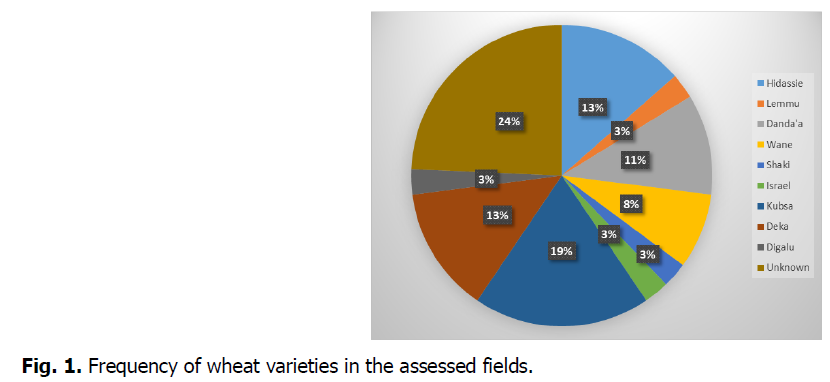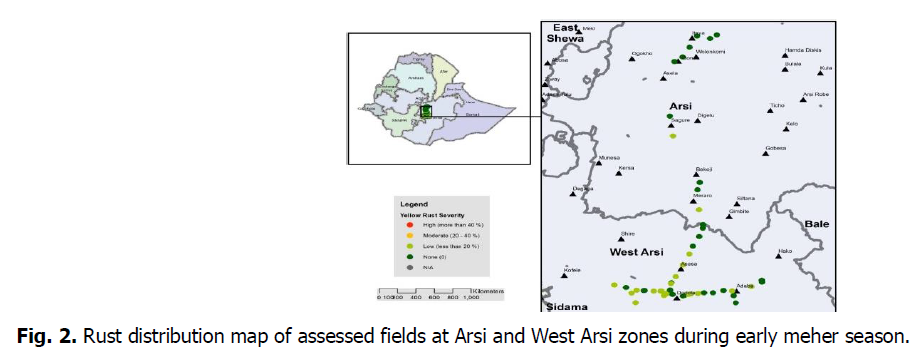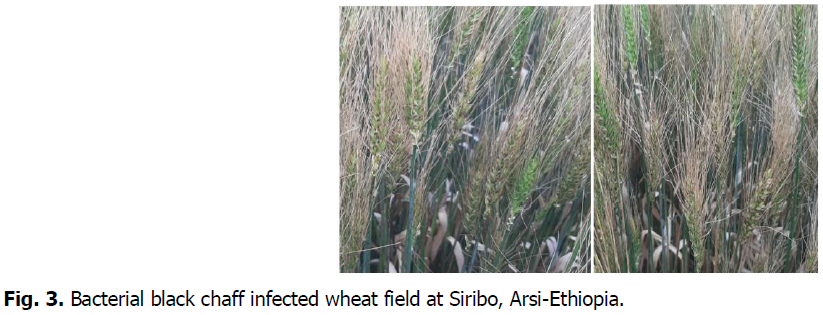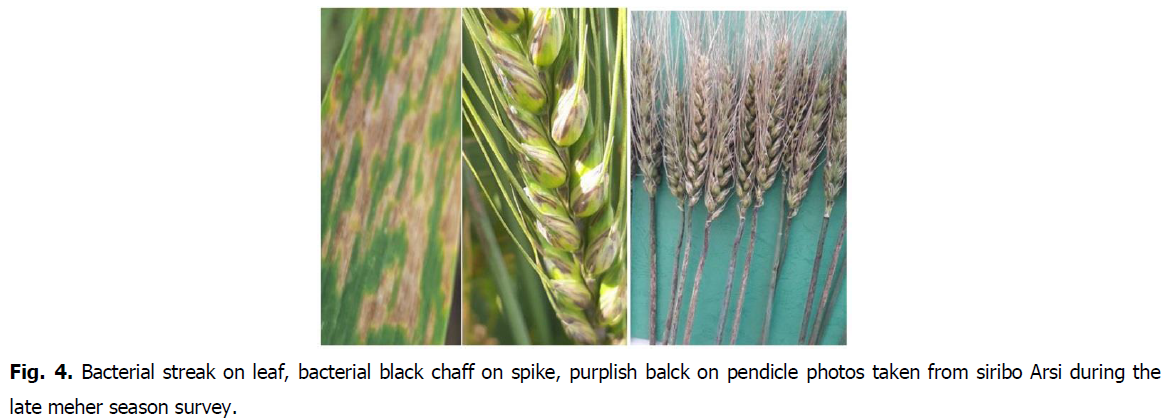Research - (2023) Volume 13, Issue 4
Survey of major wheat diseases in wheat producing areas of South East Ethiopia
A.A. Zerihun*, T.N. Gure, G.M. Abebel and D.K. HmariamAbstract
The Ethiopian highlands are suitable environment for wheat production and conducive for perpetuating of several wheat diseases including rusts. In 2022 during belg, early and late meher seasons, monitoring was conducted to determine distribution and extent of major wheat diseases. The survey result showed that yellow rust, fusarium head blight followed bacterial black chaff and stem rust diseases were the most economically important wheat production limiting constraints in the surveyed areas respectively. The dominant wheat cultivars grown in the assessed fields were Hidassie, Lemmu, Danda’a, Wane, Shaki, Israel, Kubsa, Deka, Digalu and unknown with coverage frequency of 13%, 3%, 11%, 8%, 3%, 3%, 19%, 13%, 3%, 24% respectively. Over all assessed fields maximum disease severities were recorded and wheat fields were infected by yellow rust at tillering to heading; bacterial black chaff during booting to dough growth stage and fusarium head blight at flowering to dough wheat growth stage with higher epidemics on popular varieties. Therefore, wheat foliar mainly rusts, fusarium head blight and bacterial diseases are economically important constraints to wheat production currently in Ethiopia particularly in Arsi and West Arsi potential wheat growing areas. The wheat cultivars that grown during growing seasons was susceptible to yellow rust that needs frequent application and replacement of recently released wheat cultivars besides future interventions to be taken to reduce its epidemics.
Keywords
Yellow rust, Fusarium head blight, Bacterial black chaff, Severity, Epidemics, Incidence.
Introduction
Globally, wheat is the most important food security cereal crop which is cultivated on 216 million hectors in 766 million metric tons (Grot, et al., 2021; CSA, 2021). Currently in Ethiopia wheat production is expanding in extreme highlands to low lands which stands 6.9 million tons on 2.1 million hectors during belg, meher and irrigated wheat with productivity of 3.05 and 4 tons per hector under rain-fed and irrigation respectively (Wuletaw, et al., 2022).
Currently, wheat production is faced by biotic and abiotic challenges that limits its productivity below expected country’s potential yield. Among the biotic factors, recurrent rust epidemics, occurrence of fusarium head blight and bacterial leaf streak are the most important bottlenecks for wheat yield loss in Ethiopia. These recurrent disease epidemics were incurred due to monoculture practice of wheat after wheat, absence of wheat free periods throughout the year that is producing belg season from March to July, mehar season from June to December and irrigated season from December to April, cultivation of susceptible and obsolete cultivars for long production years, inappropriate planting of varieties with recommended agro-ecologies with lack of varietal deployment regulation and climate change increases production cost and yield loss. The Ethiopian highlands are suitable environment for wheat production and conducive for perpetuating of several wheat diseases including rusts. In Ethiopia, more than 5% of wheat suitable area is hot spot to yellow rust which 66% is in Amhara, 27.6% in Oromia and 6.4% in other remaining regions, but 24% of wheat growing area is also prone to stem rust of which 68% in Oromia, 25% in SNNP regions and 8% in other regions. Over all 22% of wheat potential area is prone to both stem and yellow rust of these 85% is located in south eastern Ethiopia mainly in Arsi, West Arsi and Bale Zones (Badebo, A., Abeyo, B., 2022). So genetic improvement has vital role in developing durable resistant genotypes and to avoid susceptible and obsolete varieties cultivated for long periods in production that increases chance of disease epidemics. Timely monitoring and early warning system is crucial tactic to predict the direction and severity of disease epidemic to address information to the stake holders, avail and make decision on effective fungicides in use. Hence, the assessment was accompanied with aim of determining major wheat diseases intensity and distribution in potential wheat growing area of south eastern Ethiopia.
Methods
The study was carried out in major wheat growing areas during belg, early meher and late meher seasons of Arsi and West Arsi zones of south eastern Ethiopia during 2022 cropping seasons. A total of seventy two wheat fields were assessed, forty six fields were assessed during the belg, early meher and late meher seasons from different districts of Arsi and twenty six wheat fields were assessed during early from seedling to stem elongation crop stage and late meher from early milk to hard dough growth stage of seasons from West Arsi zone following the main roads accessible routs along the field by placing randomly 50 cm by 50 cm quadrant in four spots per field. To choice wheat growing districts and to select wheat fields purposive multistage sampling strategy and random sampling methods were applied respectively. In each sampling point and global positioning system (GPS) coordinates were taken by ODK (open data kit) and stops were made by vehicle odometers at every 5-7 km interval of wheat parcel to generate maps using the geographical information system (GIS) software Arc Map 10.3 (Table 1).
| Location name | Geographical Locations | |||
|---|---|---|---|---|
| Zone | District | Latitude (Easting) | Longitude (Northing) | Altitude |
| West Arsi | Kofele | 7.0202038-7.031515 | 38.9571223-38.9979014 | 2534-2568 |
| Dodola | 6.9826638-7.0087061 | 39.060788-39.1540921 | 2413-2470 | |
| Adaba | 7.0067949-7.0240699 | 39.3433441-39.4417384 | 2367-2451 | |
| Asasa | 7.0381086-7.2838827 | 39.1576751-39.2705157 | 2385-2612 | |
| Arsi | Lemu bilbilo | 7.2990412-7.6934489 | 39.1644805-39.2708657 | 2454-2967 |
| Digalu and Tijo | 7.7811676 | 39.1529498 | 2563 | |
| Tiyo | 8.0236981-8.0433893 | 39.1692391-39.1981914 | 2220-2260 | |
| Hitosa | 8.0870326-8.1424752 | 39.2228472-39.3191193 | 2105-2198 | |
Table 1. Geographical coordinates (latitude/northing, longitude/easting and altitude/elevation) of surveyed area.
Disease (incidence, severity, prevalence and index) data and varietal response were taken accordingly. Yellow rust disease incidence was assessed by the proportion of infected plants as percentage of total number of assessed plants within quadrants, while its severity of yellow rust was scored using modified Cobb scale (Peterson, et al., 1948).
The incidence of Fusariam head blight was Fusariam head blight disease incidence (DI) was resulted by calculating the diseased plants that showed infected symptoms of the total number of assessed spikes within quadrant in the field, whereas disease severity was determined in rate scale of 0 to 9 whear: 1=no symptoms, 2=<5%severity scores, 3=5-15%, 4=16-25%, 5=26-45%, 6=46-65%, 7=66-85%, 8=86-95%, and 9=96-100% (Miedaner, et al., 1996) and severity scores were converted to percent of disease severity index using the formula recommended by wheeler and Kumer, et al., 2011.
Results and Discussion
The survey covered a total of seventy two wheat fields planted with fourteen different released varieties and two unknown cultivars which were different to identify across in all assessed fields. Among, 76% of wheat fields were covered by improved varieties and the remaining 24% was covered by unidentified wheat cultivars. Accordingly, the disease prevalence and distribution was increasing in all surveyed fields. The wheat cultivars that grown during the belg season were susceptible to yellow rust that needs frequent application and replacement of recently released wheat cultivars (Table 2 and Table 3).
| Location | Variety | Growth stage | Yellow rust | ||
|---|---|---|---|---|---|
| Incidence | Severity | Reaction | |||
| Jeju | K6294A | Booting | 50 | 10 | S |
| Jeju | K6294A | Milky | 50 | 10 | S |
| Lode Hitosa | K6294A | Booting | 50 | 20 | S |
| Jeju | K6294A | Flowering | 100 | 50 | S |
| Jeju | Unknown | Booting | 80 | 30 | S |
| Jeju | K6294A | Booting | 0 | 0 | 0 |
| Jeju | K6294A | Flowering | 5 | 5 | MSS |
| Jeju | K6294A | Flowering | 20 | 20 | S |
Table 2. Response of cultivars to yellow rust during Belg season survey at Arsi zone.
| Zone | Variety | Number of Fields Assessed Fields | Yellow rust | |
|---|---|---|---|---|
| Incidence (%) | Severity | |||
| Unknown | 10 | 0-20 | 0-10S | |
| West Arsi | Kubsa | 5 | 0-20 | 0-10S |
| Deka | 1 | 0 | 0 | |
| Unknown | 5 | 0-20 | 0-10S | |
| Deka | 2 | 0 | 0 | |
| Arsi | Hidassie | 1 | 20 | 10S |
| Wane | 1 | 0 | 0 | |
| Kubsa | 1 | 0 | 0 | |
Table 3. Yellow rust incidence and severity of early Meher season at Arsi and West Arsi zones.
The most prevailing cultivars cultivated in the study areas were Hidassie (13%), Lemmu (3%), Danda’a (11%), Wane (8%), Shaki (3%), Israel (3%), Kubsa (19%), Deka (13%), Digalu (3%) and unknown (24%) with disease incidence of 20-40%, 40%, 20-40%, 40%, 40%, 20%, 40%, 60%, 20% and 40% respectively (Fig. 1). The prevalence of fusariam head blight was 100% across the inspected districts of West Arsi zone and 42 to 100% across Arsi zone districts (Fig. 2 and Table 4). This high distribution and prevalence of yellow rust and fusariam head blight as well as bacterial diseases on dominant cultivars across districts were becoming major wheat production constraint. Most of wheat cultivars grown in farmers field were infected by the disease might be previous harvested seeds are infected that causes for seedling blight and contributes for disease spread and initiates for disease epidemics (Table 4). In Ethiopia the survey results indicated that wheat yellow rust and Fusariam head blight diseases are increasing from time to time due to monoculture practice of wheat after wheat, continuous cultivation of susceptible and obsolete cultivars for long period of time and climate change that increases for appearance of new path type. Despite the fact the fusariam head blight disease and bacterial black chaff diseases were newly emerging and distributed to wide wheat production areas, majority of wheat growing stake holders including farmers didn’t take any actions against the diseases because of their insufficient knowledge for newly appeared diseases (Fig. 3 and Fig. 4).This revealed that conducive environmental conditions favors for diseases epidemics during the cropping season. Bacterial disease and fusariam head blight diseases are sporadic in nature and their distribution is vastly determined by environmental factors (Parry, et al., 1995; Martinez, et al., 2012). According to Mobasser, et al., (2012) findings informal seeds sources can increase FHB level in wheat growing areas by contributing as sources of disease inoculum.

Fig 1: Frequency of wheat varieties in the assessed fields.

Fig 2: Rust distribution map of assessed fields at Arsi and West Arsi zones during early meher season.
| Surveyed Zone | District | FHB incidence | FHB severity | FHB Index | FHB prevalence |
|---|---|---|---|---|---|
| West Arsi | Kofele | 95 | 40 | 38 | 100 |
| Dodola | 85 | 32.5 | 27.6 | 100 | |
| Gedeb Asasa | 23.3 | 6 | 1.4 | 100 | |
| Zonal mean | 67.8 | 26.2 | 22.3 | 100 | |
| Lemu and Bilbilo | 7.1 | 2.1 | 0.15 | 42.8 | |
| Digalu and Tijo | 31.6 | 11 | 3.47 | 83.3 | |
| Tiyo | 30 | 15.3 | 4.6 | 87.5 | |
| Arsi | Lode Hitosa | 13.3 | 3.3 | 0.44 | 66.6 |
| Hitosa | 15 | 4 | 0.6 | 100 | |
| Arsi Robe | 28 | 7 | 1.96 | 100 | |
| Zonal mean | 17.9 | 6.09 | 1.6 | 85.7 |
Table 4. Prevalence and severity of FHB in Late meher season survey at Arsi and West Arsi zones.

Fig 3: Bacterial black chaff infected wheat field at Siribo, Arsi-Ethiopia.

Fig 4: Bacterial streak on leaf, bacterial black chaff on spike, purplish balck on pendicle photos taken from siribo Arsi during the late meher season survey.
Most of the mega wheat cultivars formerly under cultivation in the assessed areas were showed susceptible to all diseases with substantial yield and quality loss. None of the grown cultivars were showed resistant to yellow rust (Table 5) and for fusariam head blight (Table 4). The findings done by Mamluk, et al., (2000) and Bekele (1990) stated that majority of wheat cultivars grown by Ethiopian farmers were susceptible to major wheat diseases.
| Zone | Variety | Yellow rust | Stem rust | Septoria | |||
|---|---|---|---|---|---|---|---|
| Incidence (%) | Severity | Incidence (%) | Severity | Incidence (%) | Severity | ||
| West Arsi | Kubsa | >40 | 20mss | 0-40 | 0-20s | 0-20 | 0-83 |
| Deka | 0-20 | 5mrms | 0-20 | 0-5mss | 0-20 | 0-81 | |
| Dursa | 0 | 0 | 0 | 0 | 0 | 0 | |
| Hidassie | >40 | 20mss | 0 | 0 | 20 | 0-84 | |
| Wane | 0 | 0 | 0 | 0 | 0 | 0 | |
| Unkown | 0-40 | 0-10s | 0-40 | 0-10ms | 0 | 0 | |
| Hidassie | 20-40 | 30mss | 0 | 0 | 0-20 | 0-85 | |
| Lemmu | >40 | 30s | 0 | 0 | 0 | 0 | |
| Danada'a | 0-20 | 5ms | 0 | 0 | 0-20 | 0-32 | |
| Arsi | Wane | >40 | 10-40s | 0 | 0 | 0-40 | 0-53 |
| Shaki | >40 | 60s | 0 | 0 | 0 | 0 | |
| Israel | 20 | 10ms | 0 | 0 | 0 | 0 | |
| Kubsa | 20 | 5mss | 0 | 0 | 0-20 | 52-83 | |
| Deka | 0-60 | 0-50s | 0 | 0 | 0-20 | 0-83 | |
| Digalu | 20 | 10ms | 0 | 0 | 0 | 0 | |
| Unkown | >40 | 0-50s | 0 | 0 | 0-40 | 0-64 | |
Table 5. Rust distributions in wheat producing areas of West Arsi and Arsi during Late Meher season.
Conclusion
A total of seventy two wheat fields were assessed, forty six fields were assessed during the belg, early meher and late meher season from different districts of Arsi and twenty six wheat fields were assessed from West Arsi following the main roads. The survey result revealed that assessed wheat fields were infected by yellow rust at tillering to heading by infecting wheat spike, bacterial black chaff under cool to worm season and high humidity during booting to dough growth stage at highland wheat growing fields. However, fusarium head blight under high rain fall, warm temperature and humid conditions in midlands in early stage of kernel development and flowering to dough wheat growth stage was with higher epidemics on popular varieties that causes quantitative and qualitative losses. Timely monitoring the level resistance of mega cultivars to diseases, analyzing the data, predicting the direction and rust epidemics and advocating and delivering the information to stack holders and farming communities on integrated disease management including fungicide attentiveness and use could be addressed as key tactics to take action and minimize crop loss.
Acknowledgement
The authors kindly thank Ethiopian institute of Agricultural Research (EIAR), Kulumsa Agricultural Research Center (KARC) for logestic provision of the research for financial support and facilities required to the study.The authors also indibeted CIMMYT Ethiopia for partial finanicial support support of the study.
Conflict of Interest
There is no any conflict of interest legal requirements and ethical Ethiopia’s guidelines of the study.
References
Abeyo, B., Badebo, A. (2022). The CIMMYT wheat breeding strategies and its relevance to Ethiopia. Revitalizing the Ethiopian Wheat Sector: Progresses and Challenges of Wheat Research and Seed Production.
Bekele, E. (1990). Identification of Fusarium spp. and Mycotoxins Associated with Head Blight of wheat in Ethiopia.
Central Statistics Agency for Ethiopia. (2021). Agricultural sample survey of area and production of major crops.
Grote, U., Fasse, A., Nguyen, T.T., Erenstein, O. (2021). Food security and the dynamics of wheat and maize value chains in Africa and Asia. Frontiers in Sustainable Food Systems, 4:617009.
Kumar, K., Xi, K., Turkington, T.K., Tekauz, A., Helm, J.H., Tewari, J.P. (2011). Evaluation of a detached leaf assay to measure fusarium head blight resistance components in barley. Canadian Journal of Plant Pathology, 33:364-374.
Mamluk, O.F., El-Daoudi, Y.H., Bekele, E., Solh, M.B., Ahmed, M.S., Mahir, M.A., Bahamish, H.S. (2000). Wheat leaf and stem rusts in the nile valley and red sea region. ICARDA/NVRSRP Cairo, Egypt.
Martínez, M., Moschini, R., Barreto, D., Comerio, R. (2012). Effect of environment on Fusarium head blight intensity and deoxynivalenol content in wheat grains: development of a forecasting system. Cereal Research Communications, 40:74-84.
Miedaner, T., Gang, G., Geiger, H.H. (1996). Quantitative-genetic basis of aggressiveness of 42 isolates of Fusarium culmorum for winter rye head blight.
Mobasser, S., Jazayeri, M.R., Khazaei, F., Sadeghi, L. (2012). Wheat seed contamination with seed-borne diseases in cold climatic zone of Iran.
Parry, D.W., Jenkinson, P., McLeod, L. (1995). Fusarium ear blight (scab) in small grain cereals-a review. Plant Pathology, 44:207-238.
Peterson, R.F., Campbell, A.B., Hannah, A.E. (1948). A diagrammatic scale for estimating rust intensity on leaves and stems of cereals. Canadian Journal of Research, 26:496-500.
Tadesse, W., Zegeye, H., Debele, T., Kassa, D., Shiferaw, W., Solomon, T., Assefa, S. (2022). Wheat production and breeding in ethiopia: retrospect and prospects. Crop Breeding, Genetics and Genomics.
Liu, X.N., Liu, H.K., Huang, Y.F., Ye, Y.L. (2015). Relationships between nitrogen application rate soil nitrate-nitrogen, plant nitrogen concentration and wheat scab. Journal of Plant Nutrient and Fertilization, 21:306-317.
Author Info
A.A. Zerihun*, T.N. Gure, G.M. Abebel and D.K. HmariamCitation: Zerihun, A.A., Gure, T.N., Abebel, G.M., Hmariam, D.K. (2023). Survey of major wheat diseases in wheat producing areas of South East Ethiopia. Ukrainian Journal of Ecology. 13: 8-13.
Received: 03-Apr-2023, Manuscript No. UJE-23-97320; , Pre QC No. P-97320; Editor assigned: 05-Apr-2023, Pre QC No. P-97320; Reviewed: 17-Apr-2023, QC No. Q-97320; Revised: 22-Apr-2023, Manuscript No. R-97320; Published: 29-Apr-2023, DOI: 10.15421/2023_439
Copyright: This is an open access article distributed under the terms of the Creative Commons Attribution License, which permits unrestricted use, distribution, and reproduction in any medium, provided the original work is properly cited.
